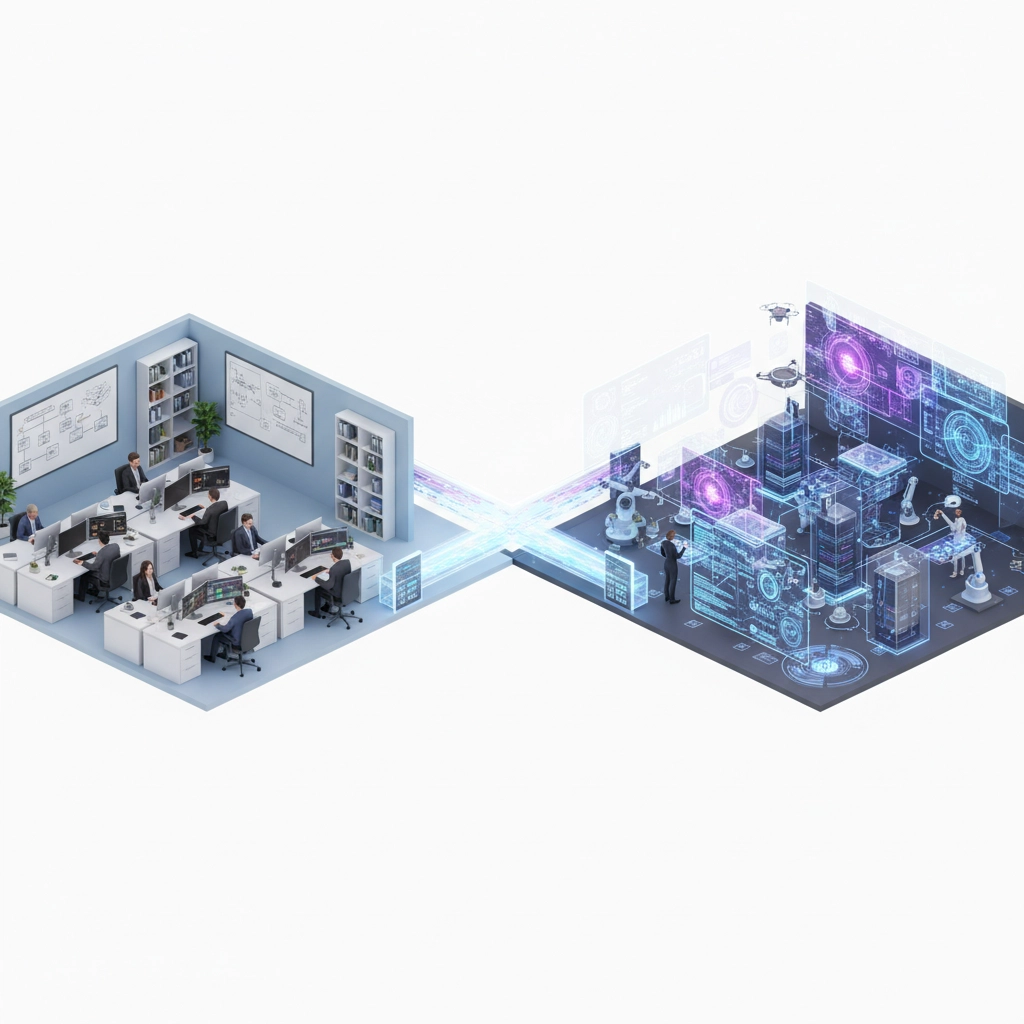Agentic AI vs Traditional RevOps: Which Is Better For Your B2B SaaS in 2025?
You're facing a critical decision that will shape your B2B SaaS growth trajectory: should you stick with traditional RevOps approaches or make the leap to agentic AI systems? I've seen firsthand how this choice can make or break scaling efforts, and the stakes have never been higher in 2025's competitive landscape.
The pressure is real. Your traditional RevOps setup might be hitting its limits just when you need maximum efficiency. Meanwhile, agentic AI promises autonomous operations that could revolutionize how your team works: but comes with complexity and investment requirements that can seem daunting.
Let me cut through the hype and give you the practical breakdown you need to make the right choice for your specific situation.
Understanding Traditional RevOps: The Reliable Workhorse
Traditional RevOps operates like a well-trained assistant: excellent at specific tasks but always waiting for your next instruction. These systems excel at rule-based, task-specific operations where you input parameters and get consistent, predictable outputs.
Think of your current setup: it might automatically flag underperforming campaigns, predict demand based on historical data, or route qualified leads to the right sales reps. But here's where it stops: waiting for human review, approval, and action before moving to the next step.
Why Traditional RevOps Still Works
Your traditional approach offers something invaluable: predictability. You know exactly what investment is required and what results to expect. Implementation typically takes weeks rather than months, and you don't need to hire AI specialists or completely restructure your operations.
These systems have been battle-tested across thousands of companies. There's comfort in knowing that your lead scoring model or pipeline forecasting follows proven methodologies that have worked for similar businesses.

Where Traditional RevOps Hits the Wall
But here's the bottleneck you're probably feeling: every insight requires human action. Your system flags that Campaign A is underperforming, but someone on your team needs to review the data, decide on adjustments, implement changes, and monitor results. That "someone" is often you or your already-stretched team.
This creates operational friction exactly when you need speed. In today's market, the time between identifying an opportunity and acting on it can determine whether you capture or lose potential revenue.
Understanding Agentic AI: Your Autonomous Operations Partner
Agentic AI fundamentally changes the game by introducing autonomous decision-making and real-time adaptation. Instead of stopping at recommendations, these systems analyze data, make decisions, and take action: continuously and independently.
Here's what this looks like in practice: an agentic system doesn't just identify that your lead response time is hurting conversion rates. It automatically adjusts routing algorithms, personalizes follow-up sequences based on prospect behavior, and optimizes timing based on engagement patterns: all without waiting for human intervention.
The Results Speak for Themselves
Organizations implementing agentic AI in their RevOps are seeing dramatic improvements:
- 28% reduction in sales cycle length
- 20-30% increases in pipeline generation
- 80% drops in lead response times
- 30-50% acceleration in overall business processes
But beyond these metrics, agentic systems solve your scaling challenge. They enable you to grow revenue without proportionally growing your team: a game-changer when every hire impacts your runway and operational complexity.

How Agentic AI Handles Complex Workflows
What sets agentic systems apart is their ability to manage multi-step reasoning across complex workflows. A marketing agent can automatically shift budget between underperforming and effective channels. A sales agent can adjust pricing strategies based on competitive intelligence. A customer success agent can proactively identify and address churn risks.
Each agent learns from interactions, continuously improving its decision-making without requiring manual retraining or rule updates.
The Head-to-Head Comparison
| Aspect | Traditional RevOps | Agentic AI RevOps |
|---|---|---|
| Decision-Making | Reactive; requires human approval | Proactive; acts autonomously |
| Implementation | Weeks; minimal technical complexity | Months; requires AI expertise |
| Scalability | Limited by team capacity | Scales independent of team size |
| Adaptation Speed | Slow manual reconfiguration | Real-time learning and adjustment |
| Sales Impact | Incremental improvements | 28% faster sales cycles |
| Upfront Investment | Lower, predictable costs | Higher initial investment |
| Best Use Case | Stable, well-defined processes | Dynamic, complex operations |
When Traditional RevOps Is Your Best Choice
Choose traditional RevOps if you're in these situations:
Early-stage validation phase: If you're still finding product-market fit, focus on proven tools that deliver immediate results. You need to validate your GTM model before adding operational complexity.
Highly regulated industry: In finance, healthcare, or other regulated sectors, autonomous decision-making creates compliance challenges. Traditional systems offer the auditability and control you need.
Limited technical resources: If you don't have AI expertise on your team and can't invest in building those capabilities, traditional RevOps provides immediate value without requiring specialized knowledge.
Straightforward processes: For well-defined, stable operations that don't change frequently, traditional automation delivers excellent ROI without unnecessary complexity.
When Agentic AI Becomes Your Competitive Advantage
Make the leap to agentic AI when:
You're competing against larger players: Agentic systems level the playing field by giving smaller teams the operational efficiency of much larger organizations. This isn't just about doing more with less: it's about doing things better than competitors with 10x your resources.
Speed is critical to your market position: In dynamic markets where customer expectations and competitive landscapes shift rapidly, agentic systems' ability to adapt in real-time becomes a crucial differentiator.
You're ready to scale without proportional hiring: If you're approaching the point where operational demands would require significant team expansion, agentic AI lets you scale revenue operations without scaling headcount.
Complex workflows are your norm: For businesses managing intricate processes across multiple systems: prospecting, qualification, pricing, forecasting: agentic systems excel where traditional approaches create bottlenecks.

The Hybrid Approach: Best of Both Worlds
Here's what I've observed among the most successful B2B SaaS companies in 2025: they're not choosing exclusively between these options. Instead, they adopt a graduated approach.
Start with traditional AI for core operations like basic customer support and foundational automations. Once these are stable and delivering value, layer in agentic systems for high-impact areas where autonomous decision-making provides the greatest advantage.
This approach lets you build AI capabilities incrementally while managing risk and resource allocation effectively. You get immediate wins from traditional systems while building toward the transformational benefits of agentic AI.
Your Action Plan Based on Company Stage
Pre-$1M ARR: Focus on traditional RevOps. Get your fundamental processes working with proven tools. Invest your limited resources in validating market demand rather than operational sophistication.
$1M-$10M ARR: This is your inflection point. Start with the hybrid approach: traditional systems for core functions, pilot agentic AI in one high-impact area like lead qualification or pipeline forecasting.
$10M+ ARR: Prioritize agentic AI to maintain competitive advantage. The operational efficiency gains become critical as you compete in established markets against well-funded competitors.
Enterprise/Regulated: Lean toward traditional RevOps or heavily customized agentic approaches. The auditability and governance requirements make standard autonomous systems challenging.
Making Your Decision
The choice between agentic AI and traditional RevOps isn't just about technology: it's about your strategic priorities and growth trajectory. Traditional RevOps offers proven reliability and immediate value. Agentic AI provides transformational capabilities that can fundamentally change how you compete.
Consider your current bottlenecks, resource constraints, and competitive position. If you're hitting scaling limits with traditional approaches and have the technical capability to implement agentic systems, the investment can pay dividends through accelerated growth and operational efficiency.
The companies that will dominate their markets in 2025 and beyond are those making strategic bets on operational capabilities today. Whether that's optimizing traditional systems or pioneering agentic AI depends on your specific context: but the decision itself can't be postponed.
Ready to explore how AI-powered RevOps could transform your B2B SaaS operations? Discover practical AI applications for scaling your GTM operations and see what's possible for your business.



